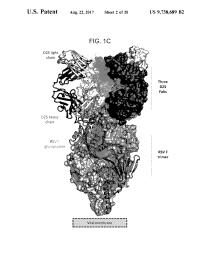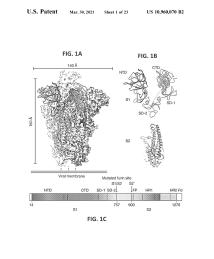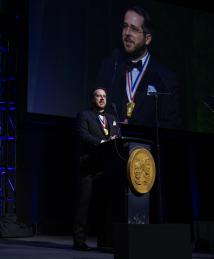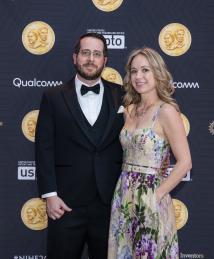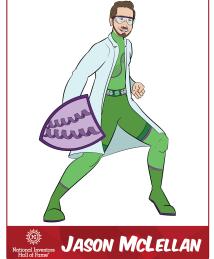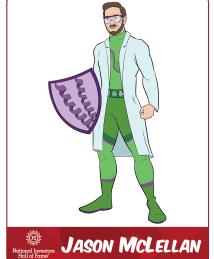Jason McLellan
"I always wanted to help people. I feel like you have some responsibility for making a positive impact on society."
Structural biologist Jason McLellan and immunologist Barney Graham used structure-based vaccine design to stabilize and modify surface proteins of viruses. Their work contributed to the development of COVID-19 vaccines, and since 2020, billions of doses of these vaccines have been administered globally. The first vaccines approved for respiratory syncytial virus (RSV) are also based on their discoveries.
McLellan was born in Michigan in 1981. Through his early years, his competitive spirit led him to participate in activities from soccer and video games to spelling bees and Science Olympiad. He said his parents never pressured him to follow a particular career path, but they taught him an important lesson that has shaped his life: “Always do your best. Find something you love and try to be the best at it.”
He earned his bachelor’s degree in chemistry from Wayne State University in 2003 and his doctorate in biophysics from Johns Hopkins University School of Medicine in 2009. Discussing his graduate school experience, McLellan said, “I was doing X-ray crystallography. You have to purify the proteins extremely well, and it's quite a rush [seeing] this beautiful crystal, sharp edges like a gem. And then you solve the structure and you're the first person to ever see the structure of that protein. It is really quite a rush. Nobody else in the history of the world is seeing the structure of this thing you just solved.”
In 2008, McLellan became a research fellow at the National Institutes of Health (NIH) Vaccine Research Center. “I always wanted to help people. I feel like you have some responsibility for making a positive impact on society,” McLellan said. “That’s why I pivoted after graduate school to go into structure-based vaccine design. I thought, ‘What better way to try to have an impact than to create vaccines and isolate antibodies and work on infectious diseases?’”
At NIH, while completing research under Peter Kwong, who pioneered methods for structure-based vaccine design in efforts to create an HIV vaccine, McLellan began collaborating with Graham, who was the deputy director and chief of the viral pathogens laboratory at the National Institute of Allergy and Infectious Diseases. Together, McLellan and Graham isolated and constructed 3D molecular models of the RSV fusion protein. They found that by locking the surface proteins into their prefusion form, they would elicit a stronger immune response. Their findings influenced the NIH Vaccine Research Center to take a more intentional approach to designing vaccines against emerging viruses that could trigger pandemics.
In 2013, McLellan became an assistant professor at Dartmouth College Geisel School of Medicine and established his own lab. Here, he began focusing on coronaviruses such as SARS and MERS, which had just emerged in late 2012. His work with Graham on RSV would prove foundational to his success.
When one of Graham’s postdoctoral students returned from Saudi Arabia with a respiratory infection, Graham’s analysis detected the HKU1 coronavirus, and McLellan’s team, including postdoctoral scientist Nianshuang Wang, determined that the addition of two residues of proline, an amino acid known for its rigidity, stabilized the spike proteins. “With the two prolines, it substantially stabilizes the protein, keeping it in the form as it exists on the surface of the infectious virus,” McLellan explained. “That way, you're raising an immune response that recognizes the actual pathogen really well.” The researchers called this strategy the 2P mutation.
In January 2020, Graham asked McLellan if he and his team would continue to collaborate to make “the world’s fastest vaccine” in response to the novel coronavirus SARS-CoV-2, the causative agent of COVID-19. Immediately, McLellan told his team, “We're going to race, get ready.” As soon as the genome sequence was released, the team got to work, and by February 2020, they had applied the 2P mutation to stabilize the SARS-CoV-2 spike protein. Their work was incorporated into the COVID-19 mRNA vaccines developed and released in late 2020 by Pfizer-BioNTech and Moderna – the first vaccines to contain elements of structure-based vaccine design and stabilized spike proteins. These vaccines direct a person’s cells to make a viral spike protein and evoke an immune response without ever having been exposed to the virus. If the person is later exposed, their immune system will recognize and attack the virus before it can infect healthy cells.
Another success came in 2023 as the Food and Drug Administration approved the RSV vaccine Arexvy®, which used McLellan and Graham’s research to stabilize the RSV fusion protein and enable the body to develop strong antibodies against it. Their stabilizing mutations also could fuel the development and production of even more vaccines in the future.
McLellan’s honors include the National Academy of Sciences Award in Molecular Biology in 2023, Dartmouth College McGuire Family Prize for Societal Impact in 2022, and the International Vaccine Institute-SK Bioscience Park MahnHoon Award, which he shared with Graham in 2024. He serves as the Robert A. Welch Chair in Chemistry at The University of Texas at Austin. “Getting into structure-based vaccine design, you think, ‘If I can help make one vaccine, that would be an incredible career achievement.’ But we've already done it twice, for RSV and coronaviruses, and now we have other things in clinical trials for different viruses,” McLellan said. “There are not a lot of viral vaccines that have been created in the history of man, and so to help contribute to two of them and possibly more – I'm very proud of that.”
